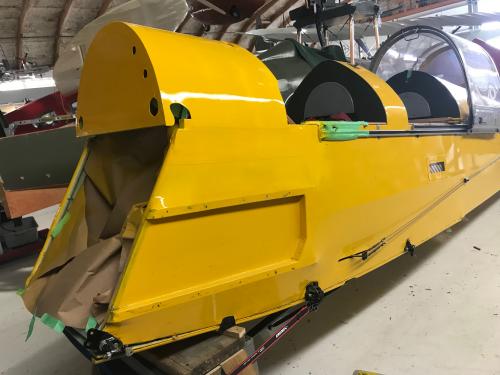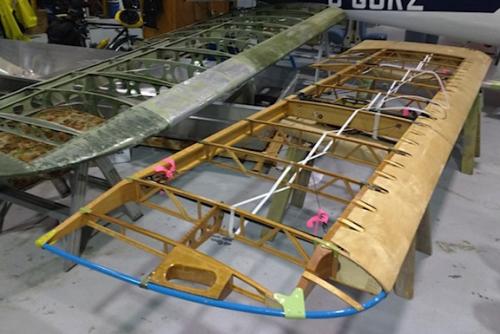
de Havilland DH 82C Tiger Moth
Flown for the first time on October 26, 1931, the Tiger Moth was derived from the DH 60 Moth. The Moth design, with the fuel tank directly above the front cockpit, restricted cockpit access for air force pilots wearing a parachute. The solution was to move the upper wing forward and sweep the wings back for correct positioning of the centre of lift. Initially the DH 82 was powered by a 120 hp Gipsy III engine, but the DH 82A received the 130 hp Gipsy Major. More than 1,000 Tiger Moths were delivered before World War 2, and subsequently 4,005 were built in the U.K. and shipped all over the world; 1,747 were built in Canada between 1938 and 1942, 1,085 in Australia and 345 in New Zealand.
The first Canadian-produced Tiger Moth flew in December 1937, with some being powered by the Menasco engine. The majority were DH 82Cs, powered by the 140 hp DH Gipsy Major 1C engine and with enclosed cockpits, cockpit heaters, brakes and tail wheels. Other changes to make them more suitable for operation in Canada included wider walkways on the lower wings, mass-balanced ailerons, metal interplane struts and heavier axles.
The Tiger Moth was a basic trainer with the BCATP (British Commonwealth Air Training Plan) during WW2, whereby aircrew from all over the British Commonwealth trained in Canada; and with the RAF in India, South Africa and elsewhere. In 1940, there were 120 Tiger Moths based at Boundary Bay, near Vancouver, BC.
Restoration of this airplane was accomplished under the first grant ever received from the British Columbia Provincial Government in 1983. The airplane was built up from a small pile of bare frames and parts, employing laid off apprentice aircraft mechanics under the direction of Harry Fordham and Bill McGarrigle. This is the Canadian version and accurate for the type.
In 1999 the volunteers of the Canadian Museum of Flight restored the static Tiger Moth to airworthy condition. At that time the RCAF numbers on the side of the aircraft were changed from 5875 (original number) to 4236 in memory of Ted Harris, a museum member / volunteer who sadly passed away before the Tiger Moth once again took to the skies. Tiger Moth 4236 was the first aircraft in which Mr. Harris soloed.
The Museum’s Tiger Moth was recorded as ‘taken on strength’ by No. 2 Training Command on 29 October 1941. It was erected at No. 8 Repair Depot in Winnipeg. It was sent to Mid-West Aircraft in Winnipeg, Manitoba for overhaul, 5 March to 8 May 1943 and flew until 27 June 1944 when it was listed as ‘pending disposal.’ This was followed by storage at No. 8 Repair Depot at No. 26 Elementary Flying Training School at Neepawa, Manitoba, where it was reported with 2366:20 total time, 1158:35 since overhaul. It was ‘struck off charge’ and handed over to War Assets Corporation for disposal on 13 March 1945.
The Tiger Moth is currently undergoing a complete restoration at the Museum. It can be seen during this time.
Geoffrey de Havilland, the company's owner and founder, had sought to produce a light aircraft superior to two of his previous designs, the de Havilland Humming Bird and de Havilland DH.51. From earlier experience, de Havilland knew the difficulty and importance of correctly sizing such an aircraft to appeal to the civilian market, such as touring, trainer, flying club, and private aviation customers; the firm had great success with a scaled-down version of the DH.51, the de Havilland DH.60 Moth.
The starting point for the DH.82 Tiger Moth was the de Havilland DH.71 Tiger Moth.[4] de Havilland had developed successively more capable Gipsy engines, and the company had produced a new low-winged monoplane aircraft to test them. This aircraft became the first aircraft to be referred to as the Tiger Moth. Improvements made on the Tiger Moth monoplane were incorporated into a military trainer variant of the DH.60 Moth, the DH.60T Moth – the T coming to stand for 'Tiger' in addition to 'Trainer'.
The DH.60T Moth had several shortcomings, thus was subject to several alterations, such as the adoption of shortened interplane struts to raise the wingtips after insufficient ground clearance was discovered while it was undergoing trials at RAF Martlesham Heath. As a result of the Martlesham trials, a favourable report for the type was produced, which in turn led to the type soon being formally adopted as the new basic trainer of the Royal Air Force (RAF). A single prototype, designated the DH.82 Tiger Moth, was ordered by the British Air Ministry under Specification 15/31, which sought a suitable ab initio training aircraft.
One of the main changes from the preceding Moth series was improved access to the front cockpit, since the training requirement specified that the front-seat occupant had to be able to escape easily, especially when wearing a parachute. Access to the front cockpit of the Moth's predecessors was restricted by the proximity of the aircraft's fuel tank, directly above the front cockpit, and the rear cabane struts for the upper wing. The solution adopted was to shift the upper wing forward but sweep the wings back to maintain the same centre of lift. Other changes included a strengthened structure, fold-down doors on both sides of the cockpit, and a revised exhaust system.
On 26 October 1931 the first 'true' Tiger Moth, the prototype E6, made its maiden flight at Stag Lane Aerodrome, Edgware, London, flown by de Havilland Chief Test Pilot Hubert Broad . Shortly thereafter construction of the first 35 production aircraft for the RAF, designated K2567-K2601, began following the issuing of Specification T.23/31; in addition two float-equipped seaplanes, S1675 and S1676, were built according to Specification T.6/33.
The Tiger Moth remained in service with the RAF until it was replaced by the de Havilland Chipmunk during the early 1950s. Many of the military surplus aircraft subsequently entered into civilian operation. Many nations have used the Tiger Moth in both military and civilian applications, and it remains in widespread use as a recreational aircraft. It is still occasionally used as a primary training aircraft, particularly for those pilots wanting to gain experience before moving on to other tailwheel aircraft. Many Tiger Moths are now employed by companies offering trial lesson experiences. The de Havilland Moth club, founded in 1975, is now an owners' association offering a mutual club and technical support.
Technical Details:

Tiger Moth Restoration
Progress report, June 2018

to the forward fuselage. Primer coats have been applied followed by the 'Tiger Moth yellow' finish.

P/N DHC1980 Front Cowling) has now been fitted and is awaiting finishing.

under restoration. Is there just a suggestion of a 1960s 'hair-in-curlers' morning?
Progress Report, January 2016




Progress Report, November 2015
The restoration is making steady progress with the fabric covering on two of the wings completed. The other two wings are structurally complete and the covering process has been started on one of them by Museum volunteers.


Trial installation of the firewall in progress
Progress Report, September 2015
The forward fuselage has been stripped and detailed inspection completed on the structural components. Metal parts have been sourced from new, or repaired as required. A new firewall (the major component between the engine and the cockpit) has been fabricated. The fabrication of wooden structure is under way. All four wings are structurally complete, with the first two nearing the end of the complex and time-consuming process of attaching the new fabric.

Alf meticuously applies heat to the fabric reinforcing strips to fasten them to the fabric



Front cockpit with rudder and brake mechanism exposed for inspection
Progress Report, June 2015




